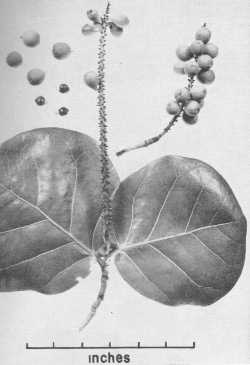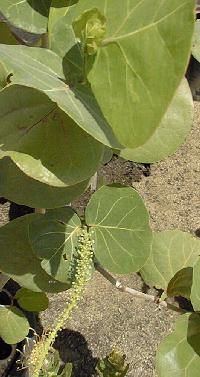Sunset®: 23-25,27
USDA: 10
Frost Tolerance: Needs protection in Phoenix, leaf damage at 32° F (0° C), branch damage at 25° F (-4° C)
Sun Exposure: Light shade
Origin: Tropical America
Growth Habits: Low shrup to small tree
Propagation: Seeds and cuttings

The Sea Grape, native to the sandy seashores of tropical America, usually forms a low shrub but may be a spreading tree 30 to 35 feet (10 m) in height. The stiff, roundish leaves may measure 8 by 7 inches (20 by 17.5 cm) and have prominent, reddish veins. The attractive appearance of the leaves on the flexuous branches and the resistance of the plant to damage by salt make it valuable as an ornamental for oceanside homes.
Blooming Habits:
The small white flowers are produced on slender, hanging racemes 4 to 10 inches long (10 to 25 cm).
Fruiting Habits:
As many as 40 or 50 fruits may be found on a single cluster, giving the appearance of a bunch of grapes.
The velvety fruits are globose to pear-shaped, about 0.75 inch long (2 cm), and range from dark purple, to purple, to occasionally off white. The edible pulp surrounds a globular seed with a short sharp point on the top. The pulp is sweetish-acid in flavor and is eaten out of hand or is used to make an excellent jelly.
Propagation:
The sea grape can be readily propagated by seeds and by cuttings of ripe wood.
Links:
Tropica Mango Nursery
Desert-Tropicals is dedicated to provide gardening advice, gardening ideas, and information about flower of all kind for landscape and collections.We try to check carefully the identification of the plants on the illustrations as well as the other information from the page, but occasionally errors do occur. if you notice anything that needs to be changed please contact us.Thanks.
© 1998-2020 Philippe Faucon, All Rights Reserved.
